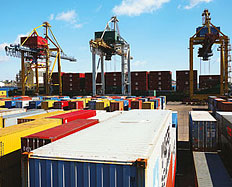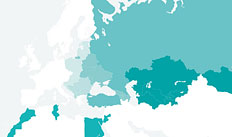COUNTRY ASSESSMENTS
Slovenia
HIGHLIGHTS OF THE PAST YEAR
- The economy entered a second recession in 2011. As yet the fallout in terms of further increases in unemployment remains contained although estimates of loan delinquencies are rising.
- The new government is committed to fiscal consolidation and has initiated pension reform and other expenditure measures. It has reached agreement on key changes with important trade unions, which should make parliamentary Acts less exposed to popular votes.
- The government has signalled its support for the substantial Šoštanj Thermal Power Plant (TES). It has announced that it intends to provide a state guarantee for part of a loan.
KEY PRIORITIES FOR 2013
- A key challenge remains to secure adequate and lasting capital support in the banking system, particularly for the largest bank, state-owned Nova Ljubljanska Banka. Clearing the banking system of non-performing loans (NPLs) will ultimately require restructuring delinquent loans while outside strategic investors will likely seek full operational control of the remaining banking institutions.
- The corporate sector is similarly in need of fresh external capital and governance reform. The proposed new holding for state assets should be adequately empowered to implement privatisation of all non-strategic assets and the withdrawal of indirect state ownership. Reducing the state’s involvement in the economy would be appropriate given Slovenia’s state of development.
- Securing fiscal stability is a key priority. In light of long-term fiscal challenges due to rapid ageing and the renewed recession, further fiscal reforms, including adjustments to the pension system, will be needed.
MACROECONOMIC PERFORMANCE
Slovenia was the first new EU member to enter a double-dip recession. Initially, the country experienced a weak recovery after the deep recession in 2009, though in 2011 GDP again contracted throughout the year. In mid-2012 all indicators of economic activity remained well below pre-crisis levels, for instance, fixed investment was over 40 per cent below the levels in 2008. Private and government consumption have remained stagnant. Competitiveness indicators also remain poor. In the central Europe region, Slovenia shows the highest relative increase in real unit labour costs, in contrast to most new EU member states which have shown declines. Following a temporary acceleration in exports and industrial production between mid-2010 and late‑2011, export growth has again been very slow since early 2012, in particular given weak demand in Italy to where 12 per cent of exports are directed. Nevertheless, given the depressed domestic demand, over the past three years Slovenia has shown no more than modest trade deficits, and overall roughly balanced current accounts.
This absence of a meaningful recovery has been reflected in mounting fiscal deficits. The general government deficit has been above 6 per cent of GDP in each of the past three years, leading to a rapid deterioration in public debt levels to about 50 per cent of GDP in mid-2012, from only 22 per cent in 2008. Soon after taking office in April 2012, the new government therefore adopted a comprehensive restructuring of public expenditure to meet a deficit target that is mandated at 3 per cent of GDP for 2013 under the EU Excessive Deficit Procedure. These measures could be adopted after the government had reached some reconciliation with the unions, preventing a recurrence of the large-scale strikes that had disrupted the public sector earlier in the year. Nevertheless, the small share of public debt that is publicly traded showed a significant deterioration in yield spreads early in the year. The public sector has very limited refinancing requirements until a Eurobond falls due in 2013. A fiscal rule, limiting public expenditures as the country approaches critical debt levels, has not yet been adopted.
Prospects for a return to growth are dim given weak trading partner growth, further credit contraction and continued fiscal consolidation. Slovenia remains exposed to weaknesses in other countries of the eurozone periphery, especially the recession in Italy, Slovenia’s largest trading partner. With no impetus in sight to domestic demand, and given the stagnation in the rest of the eurozone and fiscal consolidation under the new government, a consensus has developed that there will be a continued GDP contraction in 2012.
MAJOR STRUCTURAL REFORM DEVELOPMENTS
Progress with structural reforms has been slow over the past year. Weak support for the previous coalition government undermined three reform bills that were voted down in referenda last year, including a crucial pension reforms bill. This stalemate and the ensuing fiscal risks resulted in a number of downgrades in sovereign credit ratings (which all envisage further deterioration in risks). Following early elections in December 2011, a five-party coalition came to office in February 2012 and announced a swift reform to pension entitlements, a number of immediate expenditure cuts, and the privatisation of key banks (while retaining control through minority ownership stakes). Success will depend on preventing fresh referenda from blocking such initiatives, as has been the case repeatedly. An agreement with the trade unions on austerity measures in the public sector, reached in May 2012, is somewhat encouraging in this respect.
The financial sector remains essentially unreformed, with state banks in an increasingly entrenched position. Economic weakness has further weighed on the quality of bank assets, with non-performing loans rising to 13.1 per cent of total loans in July 2012, according to the central bank. Rating agency assessments, based on independent loan reclassifications, suggest an even higher level of loan delinquencies. Unlike other central European economies, the capital coverage of the banking sector overall is relatively low at only 9 per cent of core tier one capital, underlining the need to raise capital amid a second recession, vulnerable collateral values, and ongoing losses within the sector. Funding levels nevertheless remain secure, and the banking system as a whole has drawn down about €2.5 billion through the long-term refinancing operations (LTROs) with the ECB. Overall, the sector remains a drag on economic activity with the corporate sector repaying outstanding credit of about 3 per cent of GDP in the year to mid-2012.
Slovenia’s largest and state-owned bank, Nova Ljubljanska Banka (NLB), remains in need of an adequate and durable capital basis. As the bank failed to meet capital standards in the EU-wide stress tests in October 2011 a further capital injection was made by the state. The most significant foreign investor in Slovenia’s banking sector, Belgian bank KBC, will have to withdraw from its participation in NLB by year end, and did not participate in this capital increase. The government currently contemplates separating out poorly performing assets to make the bank more attractive for possible outside investors.
The enterprise sector continues to suffer from a high level of direct and indirect government involvement, excessive leverage and generally poor corporate governance standards. In advance of accession to the OECD in July 2010 Slovenia adopted legislation to improve the corporate governance framework for state-owned enterprises, minority shareholder protection and securities regulation though an independent agency for state-assets is now being closed down. The government has introduced in parliament a plan for a more comprehensive state holding agency, though there are concerns over the independence of its supervisory board, and to include delinquent banking sector assets.
Given a rapidly ageing population over the coming years, Slovenia will experience a rapid increase in its age-related expenditures, in particular pension payments, a factor that already weighs on sovereign credit assessments. According to projections by the European Commission, the old-age dependency ratio is expected to double within the next 30 years. The new government introduced to parliament some limited changes to the state insurance system in May 2012, though a more comprehensive reform the retirement age and of the privileges of specific groups is still outstanding. Low labour force participation rates also continue to weigh on the sustainability of finances. The government has announced plans to establish a three-pillar pension system which would require reforming the holdings of the state pension company, KAD.
Slovenia’s access to inward direct investment remains limited. Since the crisis began, inward flows have almost halved. Restrictive labour practices, regulatory impediments, and pervasive direct and indirect participations with no prospect of a comprehensive privatisation strategy continue to discourage greater access by foreign investors. The bid by a Croatian investor for Slovenia’s largest retail chain, Mercator, was put on hold, given resistance by its largest shareholder, NLB.







